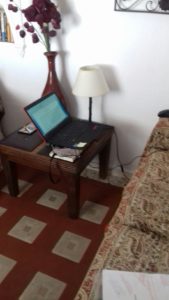To edit (v) to correct or adapt a text.
 I feel a surge of satisfaction as I click on ‘save’. I’m here in Jerez and I’ve got to the end of the first edit of the manuscript of Reconquista II. Phew!
I feel a surge of satisfaction as I click on ‘save’. I’m here in Jerez and I’ve got to the end of the first edit of the manuscript of Reconquista II. Phew!
But I know this is just an early step on the long road to publication.
What I now have is a structured story with a coherent and, I hope, exciting plot: with plausible characters who behave consistently within the plot and in relation to each other. There are, as far as I know, no glaring historical inaccuracies, though much of the story comes straight from my imagination and there is still some checking to do.
The themes of the story are, to an extent, continuations of those in Reconquista – growing up, the impact of the war, how the young people cope, their search for somewhere they can feel both safe and fulfilled. But this time I am exploring what such a place might be. What does ‘home’ mean for individuals, especially when external factors change? Is ‘home’ bound up with place, with people or with other intangibles? Each character finds their own particular answer to that question and this will require rather more work.
Nonetheless, this first edit has, I hope, removed any inconsistencies or infelicities of  plot, though there is still one aspect with which I am not entirely happy and which I’ll have to think hard about.
plot, though there is still one aspect with which I am not entirely happy and which I’ll have to think hard about.
It is, currently, a slightly longer book than its predecessor, at over 400 pages, but this may well change. As before it has three parts – In the City, In the Mountains and Home – with forty-one chapters and an Epilogue ( just so I won’t be tempted to return to these characters again ). This time the action all takes place over a fifteen day period, in February 1265, as opposed to several months. This means that the plot moves more quickly and the whole story is much more intense.
 The action flows and the reader will, I hope, be swept along or kept on tenterhooks as the story follows one character then another. A question I must consider now is the degree to which the story can sustain such switching from one strand to another. Is the narrative impaired? Is it too staccato? This is all consideration of the form of the novel: chapter lengths, time and drama afforded to each voice, balance and shape.
The action flows and the reader will, I hope, be swept along or kept on tenterhooks as the story follows one character then another. A question I must consider now is the degree to which the story can sustain such switching from one strand to another. Is the narrative impaired? Is it too staccato? This is all consideration of the form of the novel: chapter lengths, time and drama afforded to each voice, balance and shape.
Like Reconquista the story is told from multiple points of view. Nathan, Rebecca, Atta and Ben all contribute, though this time Miguel is given much more interior life than in the first book. Nathan, the semi-traumatised, mixed up teenager has most page room, followed by Rebecca, Atta and Miguel, then Ben. This is, I think, the right balance between the characters.
I have also been mindful of the discussions during the Clapham Book Festival this year about writing historical fiction and what Dame Hilary Mantel said in her 2017 Reith lectures. So I have a good idea what I need to consider for the next re-write. But first I shall have a few days off!
I you enjoyed reading this article you might also enjoy The First Draft Characters


 RSS – Posts
RSS – Posts